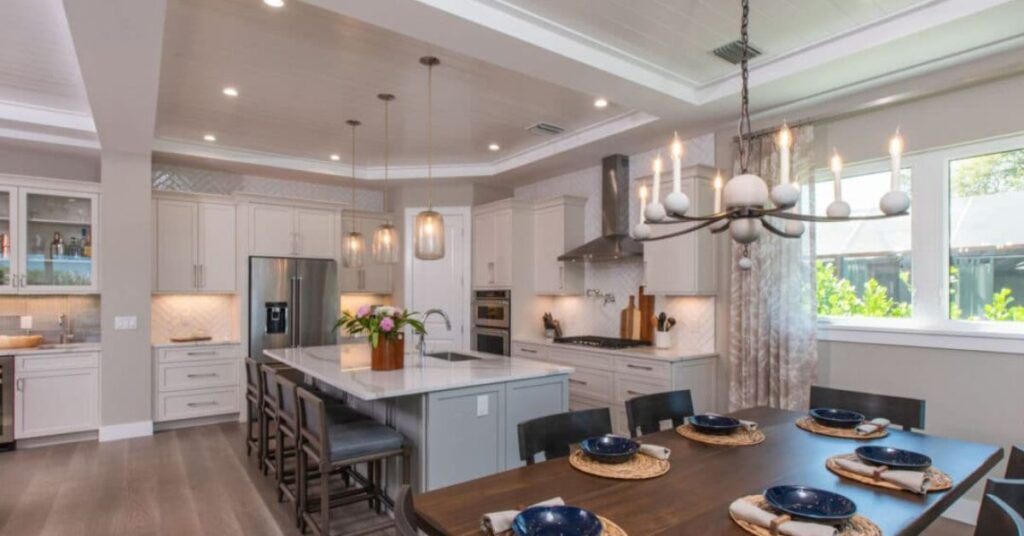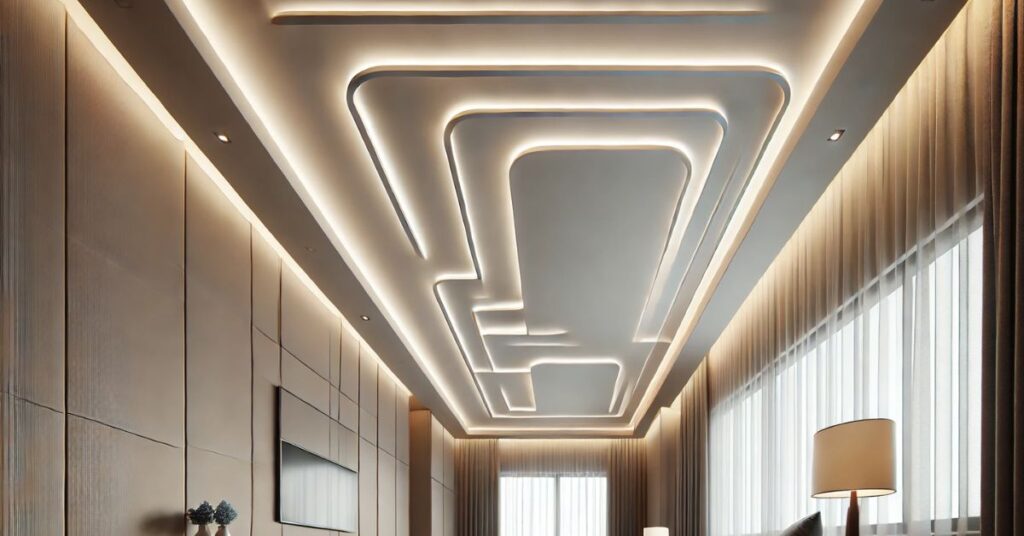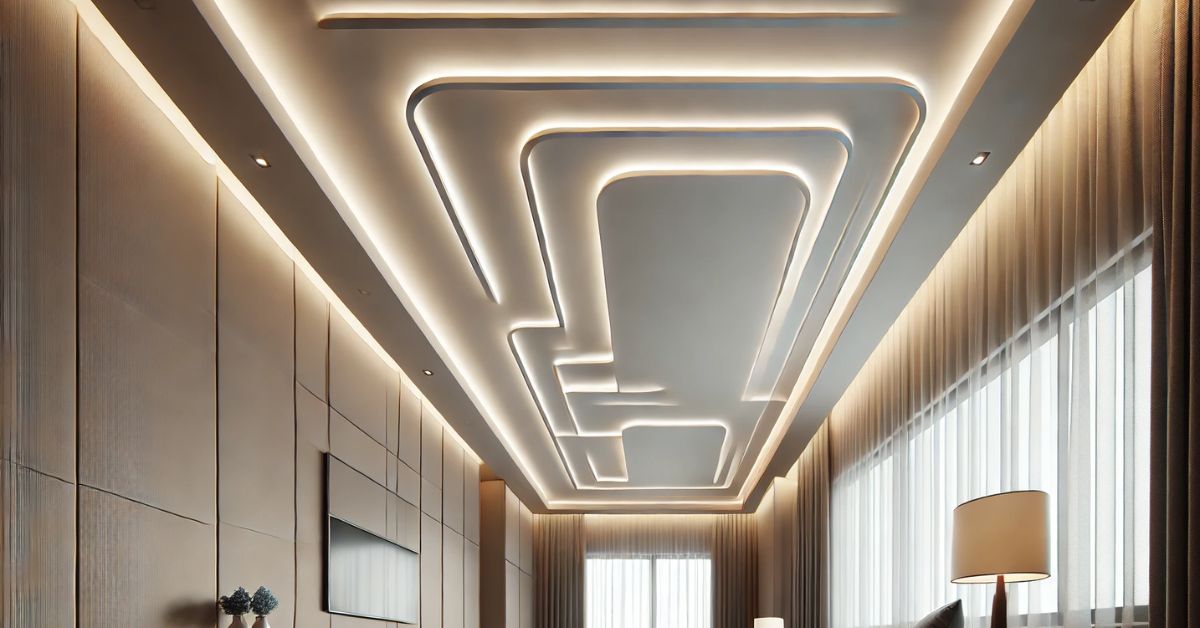In the evolving landscape of interior design, one element often underestimated is lighting. While many clients focus on furniture, paint, or finishes, it’s the lighting that ultimately defines how a space feels. Among the many lighting strategies available, diffused ceiling lights have emerged as a preferred choice in Delhi’s modern homes, offices, and retail spaces.
But why diffusion? And how does it change the way we experience a room? Let’s explore this with both technical clarity and practical insights.

What Do We Mean by “Diffused Light”?
In professional lighting design, diffusion refers to the scattering of light rays through a medium, creating a uniform spread of illumination. Unlike direct fixtures (COBs, spots, or bare LEDs), diffused panels or covers eliminate harsh glare and soften shadows.
For example:
- Direct lighting creates contrast—useful for accent walls, but tiring for workspaces.
- Diffused panel lighting in Delhi homes and offices provides a calm, even baseline illumination, closer to natural daylight.
In simpler terms, diffused lighting is the difference between squinting under a harsh spotlight and feeling comfortable in a naturally lit room.
The Science: Why Diffused Ceiling Lights Work
Here’s the professional breakdown:
- Reduced Luminance Contrast
Diffusion lowers the contrast ratio between bright fixtures and darker surroundings, making spaces visually balanced. - Glare Control
Harsh glare is a leading cause of eye strain. By spreading light across a diffuser (frosted acrylic, polycarbonate, or nano-textured panels), diffused lights maintain comfort over long hours. - Improved Uniformity Ratios
Professional lighting design recommends a uniformity ratio (average to minimum illuminance) between 0.6–0.8 for offices. Diffused ceiling panels achieve this with ease. - Closer to Daylight
Humans evolved under soft daylight scattered by the atmosphere. Diffused lighting recreates this effect indoors, improving wellness and productivity.
Where Diffused Lights Make the Most Impact
Residential Interiors
- Living rooms: Even glow enhances ambience without overpowering décor.
- Bedrooms: Warm diffused panels create a calming environment for rest.
- Kitchens: Balanced brightness reduces harsh shadows on worktops.
Workspaces
- Open-plan offices: Uniform light reduces fatigue during long work hours.
- Meeting rooms: Diffused ceiling lights paired with dimming controls provide flexibility for presentations vs. discussions.
Retail & Commercial
- Showrooms: Soft lighting ensures products are evenly visible without hotspots.
- Hospitals/clinics: Essential for patient comfort and visual clarity.
This is why soft lighting fixtures in Delhi are increasingly chosen by both architects and facility managers.
Diffused vs. Direct: Professional Comparison
| Aspect | Diffused Ceiling Lights | Direct Lighting (COBs/Spots) |
| Glare | Minimal | High if not shielded |
| Shadows | Soft, minimal | Harsh, directional |
| Uniformity | High | Medium–Low |
| Aesthetic Role | Creates ambience | Creates highlights |
| Best Use | Ambient, base illumination | Accent, task, drama |
Verdict: Use diffused LED ceiling panels in Rajouri Garden projects for baseline ambience, and layer them with COBs or track lights for accents.
Key Design Considerations (That Most Buyers Miss)
When specifying diffused ceiling lights, professionals in Delhi usually evaluate:
- Lumen Output vs. Wattage – A 36W panel with 3600 lumens is better than a 50W inefficient one.
- Color Temperature – 3000K (warm) for homes, 4000K (neutral) for offices, 5000K–6000K (cool) for task-heavy zones.
- CRI (Color Rendering Index) – For showrooms, CRI 90+ ensures true color accuracy for products.
- UGR (Unified Glare Rating) – Panels with UGR < 19 are ideal for office compliance.
- Driver Quality – Good SMPS/driver extends LED lifespan and prevents flicker.
Most people never ask these questions when they walk into a store—that’s where a good showroom makes the difference.
The Delhi Trend: Why Diffused Panels Are Everywhere
- Residential Demand: Apartments in West/South Delhi increasingly use diffused panels instead of bulky fixtures.
- Commercial Retrofits: Companies replacing old fluorescent panels with LEDs for cost + comfort.
- Hybrid Spaces: Co-working and cafés adopting diffused panel lighting in Delhi for a softer, lifestyle-oriented ambience.
This shift explains the rising demand for diffused LED ceiling panels in Rajouri Garden showrooms and across the NCR.
Where to See Them in Action
If you’re planning a project, don’t just buy from a catalog. An experience center allows you to:
- Compare panel sizes and brightness levels.
- Test warm vs. cool white side by side.
- See how diffused panels combine with COBs, track, or wall washers.
For example, The Lantern by Agarsain Bath and Lights in Rajouri Garden is one such showroom where clients—homeowners, architects, and corporates—explore these setups before finalizing.

Conclusion
Diffused ceiling lights aren’t just another lighting product—they’re a foundation for modern interior design. They balance aesthetics with comfort, improve visual ergonomics, and bring a sense of calm to spaces.
If you’re planning interiors in Delhi, prioritize diffused ceiling lights as the base layer, and then layer with accents for depth. And if you want to experience how they look in real settings, a surface-level shop won’t cut it—choose an experience center where you can test before you invest.
✨ Because great interiors don’t just look good—they feel good, and diffused lighting is at the heart of that.

